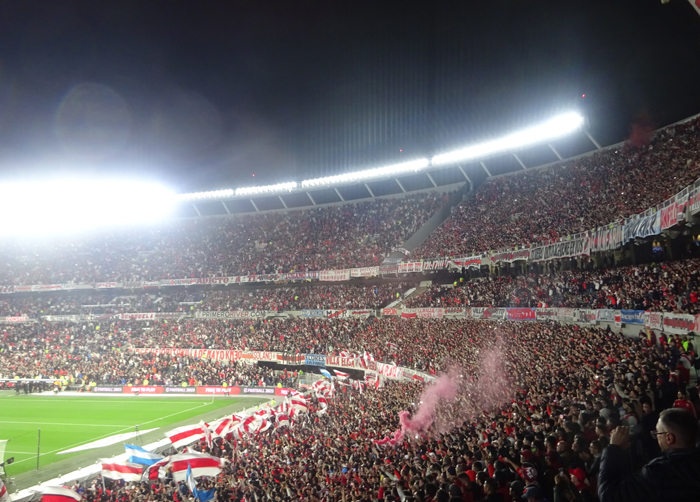Four South American countries are bidding to host the FIFA World Cup 2030. A look at the current stadium infrastructure in those countries reveals that they would have some catching up to do.
Although there are prominent stadium projects in South America, such as the planned construction of the new Vila Belmiro for Santos FC, the Arena MRV (Atlético Mineiro), which was completed in April, and the modernisation measures at River’s Más Monumental, a real construction boom could be in store for the continent due to a commitment to host the FIFA World Cup in 2030.

The Estadio Mâs Monumental, also known as El Monumental, is the home ground of River Plate.
Image: Christian Schmitt
Under the motto “Juntos 2030” (“Together 2030”), the South American Quadrilateral presented its intention to host the 2030 Jubilee World Cup. The official announcement was made in the final stadium of 1930, the Estadio Centenario in Montevideo, where the officials gathered in the museum at the same table where the South American football association CONMEBOL was founded in 1916. Just in time for the anniversary (in 1930, the Uruguayans became the first world champions), the Centenario would once again be the venue for the final, a corresponding modernisation of the stadium had already been announced and would receive a further boost from the bid.
Uruguay, as the initiator and head of the bid, is leading the Estadio Centenario as the flagship of the bid. Out of the 18 stadiums on the shortlist, seven are from Argentina, five from Paraguay and three each from Chile and Uruguay. If a country wants to enter two stadiums from one city, FIFA regulations require that exemptions be obtained. Since Montevideo is to host all the stadiums for the Uruguay event, it is likely that the Gran Parque Central will be removed from the list, despite its rich history (including hosting the opening match in 1930).
The Monumental, where Colo-Colo currently plays its home games and is also its owner, would also need it. As the second largest stadium in the country, it has a capacity of 43,667, but has not been extensively renovated since its (re-)opening in 1989. Colo-Colo has already announced its intention to do so in view of the World Cup. The stadium in Concepción, built in 1962, was modernised in 2015 according to FIFA guidelines and is already completely covered. It has already hosted the Copa América and FIFA World Youth Championships.
In Paraguay, too, the national stadium is the most likely option for a 2030 World Cup venue: the Estadio Defensores del Chaco in the capital Asunción. Initial renovation work has already been carried out for the “Juegos Suramericanos de 2022”, the South American Games, which took place in the stadium in October 2022. Further modernisations are planned in view of the World Cup. The Estadio General Pablo Rojas (popularly known as La Nueva Olla), which was reopened in August 2017, is also located in Asunción and can accommodate 45,000 spectators. It is considered one of the most modern stadiums in South America. (STADIAWORLD, 11.09.2023)
The full article can be found in the new SPORTS VENUES 2023/24. Click here to go directly to the story. Also in the yearbook: the construction report for various other countries, continents and events, a portrait of the Arthur Ashe Stadium, the Tech Report on the most important trends and topics in the industry as well as a variety of interviews.